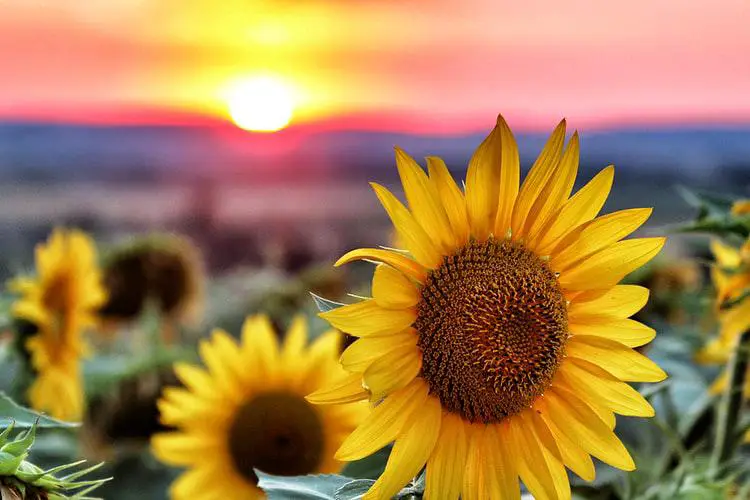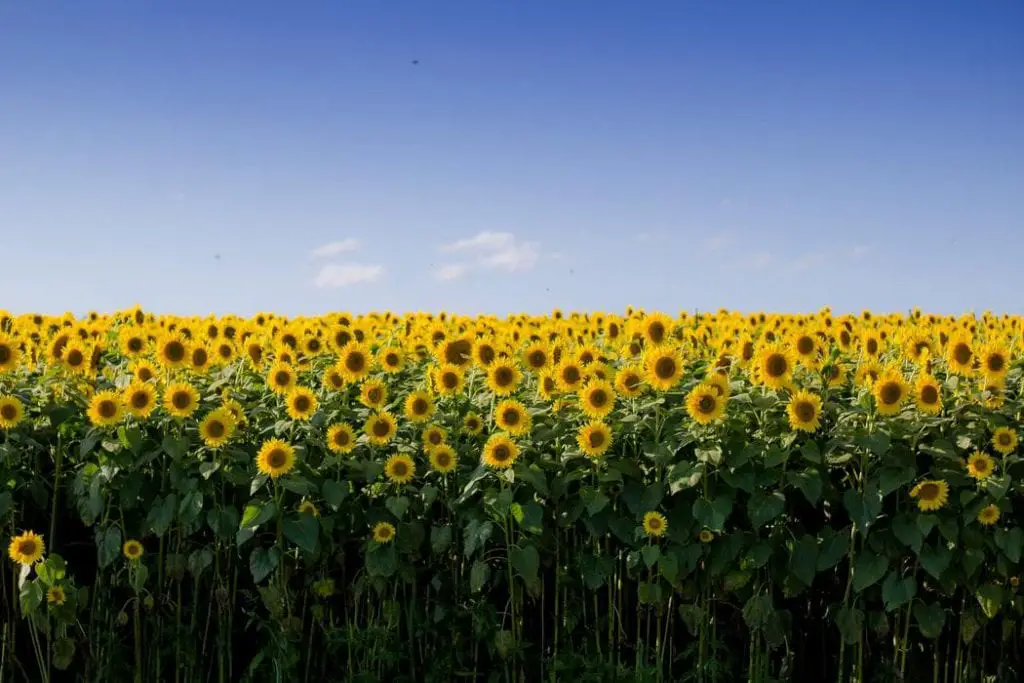
Sunflowers are beautiful tall flowers that can bloom quicker than many other garden blooms. These lovely flowers stand firm, facing the Sun, and perfectly represent positivity and confidence. Have you ever observed that you begin to feel fresh and positive when you see a sunflower? That’s right. Sunflowers can boost your mood. These yellow blooms as well can add to your garden’s beauty. Scientifically called Helianthus, Sunflower also symbolizes faith, adoration and loyalty.
If you adore sunflowers and are interested to know more Sunflower facts, you are on the right page. Go through the following lines to get an insight into the nature’s yellow wonder.
Facts about Sunflowers:
Growing Sunflowers: Sunflowers need very good Sun and properly drained soil to fully grow. Seeds attract the birds, so be very careful. You can place a nylon stocking or a mesh bag over the Sunflower blooms until the seeds fully ripen. They are one of the very few quick growing tall plants and within a period of about 6 months, they grow 9-12 feet on an average. Growing Sunflowers is not a tedious job, it is just that you need to take a few simple measures to protect them. Most importantly, you need to ensure to give your sunflowers around 8 hours of natural light every day. In fact, they stretch up so tall since they need good solar energy. When they reach their full height, you will have a lot of reasons to take pride in!
Clean Up the Soil: Did you know the Sunflowers are a natural toxin remover? Yes, these lovely large blooms can remove lead, Uranium, arsenic and other nuclear toxins from the contaminated soil. They have thus been used across the world to clean up the soil when disasters struck, including Fukushima and Chernobyl.
Sunflower Oil: The oil of this beautiful flower is loaded with iron and calcium along with Vitamins D and A. This oil is widely used as a cooking oil, and also to soften leather and condition hair. Sunflower oil is also used as a bio-diesel and medicine paint.
History & Geography: When it comes to Sunflower facts, history and geography of the flower make up an important point. The flower is native to America, and since centuries, is used to make dye, food, medicine and oil. Sunflowers were cultivated in the Americas, North America, to be precise, centuries ago. They were later exported to the other parts of the world by Spanish conquistadors. It is Ukraine’s national flower and Kansas’ State flower.
Anatomy: The Sunflower is made up of several small blooms. In fact, one large flower can contain up to 2000 seeds. The tiny blossoms at the center are a major attraction to the bees. Coming to the inside of the Sunflower, you will be surprised to learn it is made up of several small flowers. The petals on the outer part are called ray florets, while the seeds in the center have both female and male sex organs that can reproduce. They attract pollen from insects and wind as well self-pollinate. The seed formation in this flower is spiral and almost follows the well-known Fibonacci sequence.
Records: As you know, Sunflowers are largely grown across the world. A few passionate growers have set records. Some of them worth mentioning here are:
· Hans-Peter Schiffer from Germany has set the record for growing the tallest Sunflower (30 feet 1 inch) in 2014.
· In 1983, Emily Martin from British Columbia, Canada grew a Sunflower with the largest flower head.
· In 2001, Melvin Hemker set the record by growing 837 flowers on a single Sunflower plant.
· The shortest, fully mature Sunflower (92 inches in height) was grown using the Bonsai technique.
Characteristics and More:
· As said earlier, Sunflowers have a lot of seeds at their center, and can attract bees. Beekeepers, therefore, use these flowers to attract more honeybees.
· The budding stage is very interesting. During this stage, the Sunflowers display a distinctive character called heliotropism. The bud of this flower faces and follows the Sun all through the day, starting from the east in the morning and ending the day facing the west.
· While the stem of the sunflower grows up to 10 feet tall, the flower head can be 11.8 inches wide.
· In French, Sunflower is called ‘tournesol’, which means ‘turned Sun’; the most interesting among the Sunflower facts, don’t you think so?
· Yellow Sunflowers are the most widely grown. However, you should note that this is not the only color these flowers are available in. There are over 60 kinds of Sunflowers with different shades of petal colors.
· If you have Sunflowers with no seeds on the inner, you can use their flower heads as a scrubbing tool!
· There are 2 kinds of Sunflower seeds, striped and black. While the striped seeds are used to make snacks, the black ones are largely used in making oil.
· Wild Sunflowers are highly branched and come with small seeds and heads, while the cultivated kind has a big seed head and a single stem.
· Sunflowers have been harvested by several cultures since 4500 years at least.
· Vincent Van Gogh made paintings, most of them masterpieces featuring Sunflowers. His Sunflower series has successfully inspired several artists across the globe.
· Sunflowers do not kill or hinder the growth of the other plants around them. These lovely plants are humble and a mark of happiness and warmth.

Nutrient-rich Seeds: This is yet another significant point when it comes to Sunflower facts. Sunflower seeds offer a lot of benefits. For decades, these seeds have been a popular snack at football games. Audience and players munch on the tasty seeds all through the game. You can also consume sunflower seeds as an alternative if you are allergic to nuts. They are also delicious additions to certain baked goods, especially bread, while these seeds can be sprinkled over raw salads and dishes. Sunflower seeds are packed with protein, magnesium, Potassium, vitamin E, Iron and Calcium. So, if you are a snack-loving person, next time grab a cup of sunflower seeds instead of munching on high-calorie oily foods.
Sunflowers entered Russia royally: Tsar Peter the Great saw the sunny flowers in the Netherlands and instantly loved them. He was fascinated by their beauty and warmth and decided to take it to Russia. The Russian Church during those times had banned several oils and its patrons avoided consuming such oils. People were happy the Sunflower oil was not among the list of oils banned. Sunflowers became so popular in Russia that by the 19th century, the nation was planting close to 2 million acres of these flowers each year.
Stood the test of time: Russian immigrants to the USA brought back Sunflower seeds and ignited a renewed interest in the yellow-flowering plant. In 1946, when Canada invented a seed-crushing mechanical plant, the farmers of Missouri began growing these flowers on a large scale and the sunflower production literally exploded in the United States. In the 1970s, Sunflower oil became popular as people became more health-conscious. They chose this oil over the other animal-fat based ones that were high on cholesterol. To sum up, Sunflower has maintained its popularity through centuries and stood the test of time.
Healing Nature: Sunflower leaves and oil have since long been used to get relief from certain pains. The plant is believed to possess healing properties and it is a widely agreed sunflower fact. While the leaves were used to treat kidneys by the native tribes in America, the flowers were used to soothe chest ache in Mexico.
Sunflowers have been to space: Yes! Sunflowers have traveled beyond the Earth. Don Pettit, the astronaut from the U.S took along sunflower seeds on his mission to space in 2012. He blogged about his friendship with the budding sunflowers and regularly shared photos of the same.
Processed Sunflower: Sunflowers can be processed to make Sunbutter, a good substitute to peanut butter. If you love peanut butter but allergic to peanuts, Sunbutter could be the best option.
Some people are scared of sunflowers: This may sound weird but it is one of the Sunflower facts. Even though these flowers symbolize positivity, love and joy, some people develop a fear for them. This is called Helianthophobia.
They are edible: Sunflowers are edible, and they are entirely safe. While the seeds and oil are largely consumed, you would be surprised to know their leaves and petals can be eaten too! Even though these flowers don’t taste great, they are naturally healthy since they come loaded with a wide variety of nutrients.
The sunflowers, when grown in bunches in your garden, can look gorgeous. These plants are largely grown for commercial purposes since they are appealing and offer a range of nutritional benefits.
If your place receives good sunlight and you have sufficient space in your garden, grow some sunflowers and enhance the curb appeal of your home. You may have several colorful plants and flowers but this lovely yellow one truly stands out!
